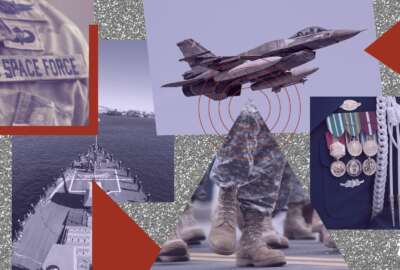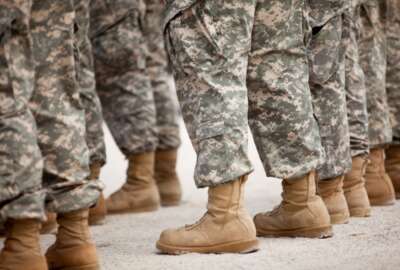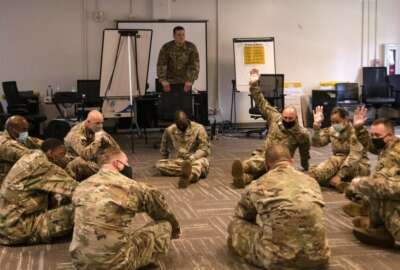
How the Army conserves 53,000 acres of training territory
Camp Ripley is a 53,000-acre civilian and military training facility operated by the Minnesota National Guard. Keeping it up and maintaining it is no trivial...
Camp Ripley is a 53,000-acre civilian and military training facility operated by the Minnesota National Guard. Keeping it up and maintaining it is no trivial matter. But Josh Pennington, the base’s environmental supervisor, is up to the task. He and his team were among winners of the 2023 Secretary of Defense Environmental Awards. To learn more, Federal Drive with Tom Temin spoke with Pennington.
Interview Transcript:
Josh Pennington Camp Ripley is a 53,000 acre training center, and it’s comprised of about 30,000 acres of forests, and other what we call grasslands and training sites, everything from maneuver planes to artillery firing points to larger range complexes. My team is made up of two components. One is the Environmental Conservation Program, and the other is the Integrated Training Area Management Program. So we have 11 personnel on total. And it’s our responsibility to manage the training lands in a sustainable way that do two things, one, facilitates military training and prevents the military from degrading the natural resources that we’re entrusted with. And then also, preventing natural resources from impeding on military training. So ensuring things like, threatened endangered species don’t lead to regulatory constraints that would then impede the military’s ability to use these sites for training.
Eric White Yeah. What are the biggest risks from military training that are present to the land as far as threatening any species of animal or other biological forces in work?
Josh Pennington Sure. So Camp Ripley is geographically located at the convergence of three ecological provinces. We have 18 miles of the Mississippi River and nine miles of the Crow Wing River. That confluence is kind of an important place ecologically. So we’ve got a lot of biodiversity on site. And what we’ve been able to demonstrate is that the military training does not have a negative impact on many species that call it home. We have everything from larger mammals, such as gray wolves and black bears. We have healthy populations of both, down to federally endangered species, such as the northern minor at bat. And then a lot of pollinators that we refer to as at risk species that are petitioned to be a federally endangered species, such as monarch and blanding’s turtles and rusty patched bumblebee and all these things. And so finding that delicate balance of being able to manage for these species, and providing military training is kind of where we are really successful.
Eric White Got you. And that provides a perfect lead into my next question, what looks like success in your eyes? And what does it look like when that balance is perfectly achieved? Is it just the military is able to do whatever they want, and also just have zero effect on the wild land? Or is that just going too far, and there’s always going to be one side affecting the other?
Josh Pennington Well, there’s always going to be some level of impact. And I think where we find the most success is through our integration efforts, and synchronizing our efforts with the conservation values of the landscape. So a perfect example of that is on our larger maneuver lanes where there is maneuver damage. We’re providing soldiers with the critical training they need so that when they’re called upon for our nation’s worst day, they’ve got the training and the confidence they need on the equipment that they’re using. So any event that they do have any kind of large land disturbance areas, we are kind of the housekeepers. We go back, we regrade the area, we reseed it, and we make a sustainable so that for the next units coming in, that land is of perfect training value. And we do that in a way that has a lot of ecological value. So we use all native plants and all of our restoration efforts. We do a lot of our seed harvesting on site, which saves the government thousands of dollars by not having to go out and purchase seed for these locations. And it’s also a good locally ecological sink for seeds that the plants are growing right here.
Eric White And for the animals that you mentioned earlier, is their trapping release efforts going on or what other ideas are there behind making sure that those endangered species don’t come into contact with any of the military training going on?
Josh Pennington Yeah. So we have a very proactive program here that’s integrated with the Fish and Wildlife Service and the Department of Natural Resources, and we do a lot of surveys. So all those surveys provide the critical data that we need to assess what habitats these species are using. We overlay that with all the military training, and then we find that common ground. And so we have cooperative agreements established with both of these agencies that helps us study these animals, especially species like the Northern long-eared bat. And we set timing on certain training areas for usage. So when we know that the bat is roosting, it has maternity roosts where they’re giving birth to pups, they may be impacted by certain activities. And so we’re able to buffer those activities without completely restricting military training, but just working together to find areas that they can train while these other areas are temporarily closed.
Eric White You mentioned the DNR and other natural wildlife that you coordinate with. Are there any other agencies that you do work with to maintain the area around the base?
Josh Pennington Absolutely. And I think one of the reasons, if you notice that Camp Ripley was selected as the winner of both, the Department of Defense and the Secretary of the Army, Environmental Award for Natural Resource Conservation. Personally, I think one of the reasons for that, is our level of integration and use of partnerships to facilitate common interests. It would take all day to sit here and list all the partnerships we have. We are one of ten federally designated sentinel landscapes in the entire country, and the landscape is a large landscape anchored by a military base that prioritizes the resources from the USDA and Department of Interior and the Department of Defense to essentially do just that. Prioritize our resources into a common landscape to do the greater good. So we have partnerships with agencies such as [Natural Resource Conservation Service (NRCS)], the National Association of Conservation Districts, our Solar and Water conservation districts, our board of water into our resources. Lot of great work that’s going on, both within defense of capability but also outside defense. One example of work outside defense is the Natural Resource Conservation Service, the NRCs. They wanted to do more forest stewardship activities within the sentinel landscape around Camp Ripley. And a lot of this is like writing burn plans for prescribed fire to do wildfire mitigation efforts. But they didn’t have a location to staff a full time forester. So Camp Ripley was able to partner with this organization. They provide the staff member, we provide the office and supervisory support, and so we host a private land forester on the installation, and he doesn’t do any work on the installation. He’s housed out of here, but all of his work is with private landowners surrounding Camp Ripley.
Eric White Got it. We’re speaking with Joshua Pennington, environmental supervisor for Camp Ripley in Minnesota. And I know you have a lot to worry about with your own 53,000 acres, but I am curious, where does Camp Ripley stand in comparison to other bases? Are there any other bases that are this biodiverse and have this kind of, I imagine there are larger ones, but has this sort of land that has to be maintained like this?
Josh Pennington And we’re pretty humbled to be receiving the recognition at the DoD level, because there are a lot of installations out there across all services that are doing incredible work in the conservation natural resource field. And it’s across the country, Air Force, Army, National Guard, Marines, they all have different installations with natural resource personnel, with partnerships, and they’re all doing wonderful things.
Eric White Is there any bragging going on between you and your counterparts at other bases?
Josh Pennington Oh, yeah, absolutely. And that’s what keeps it fun. But we also learn from each other a lot, too. And so I’ll travel to colleagues that work at other installations in Florida, for example. And while Florida and Minnesota have a lot of differences, there are areas where we can learn from them and adopt a lot of their practices. And so we’ve done that to different scales. And yeah, there’s always a lot to be learned. There’s conferences throughout the year where we are able to get together with our colleagues from other installations and other services and learn from one another. And we’ve actually obtained federal agency partners based off work from other installations that they kind of do the groundwork for.
Eric White Anything else that we haven’t touched on that you think is important for the conversation?
Josh Pennington I just think that it’s probably not well understood the amount of conservation work that goes on across military installations. The Department of Defense manages 25 million acres across the country, and everything from climate resiliency projects to threatened endangered species conservation. There’s a lot of really great work going on.
Copyright © 2025 Federal News Network. All rights reserved. This website is not intended for users located within the European Economic Area.
Tom Temin is host of the Federal Drive and has been providing insight on federal technology and management issues for more than 30 years.
Follow @tteminWFED





